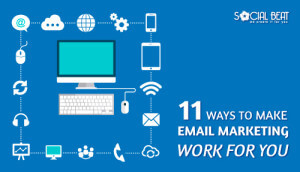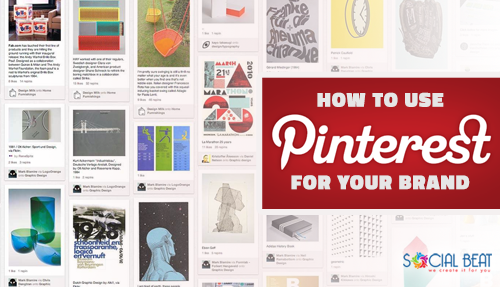Want to maintain a good relationship with your customers and clients? The best way to do that is by constantly keeping in touch and updating them. Email is perhaps the easiest way to do this. Email marketing is the best resource for both start up and established companies, especially e-retail ventures. According to studies, the total number of worldwide email accounts is expected to increase from nearly 3.9 billion accounts to over 4.9 billion accounts by the end of 2017. In a 2015 study from BlueHornet, over 77% of consumers buy products and services from marketing/advertising emails at least once a month or more. So make sure you include email marketing as part of your marketing plan. Here are a few tips to make email marketing work for you. We also have a detailed checklist for emailer marketing.
1. Make it personal
Personalization increases response rates tremendously. Whatever be your vertical, your customers would rather want an email personalized to them than a bulk mail. Use names in email messages to grab attention. Make sure you spell the names right. You don’t want to send out an email with the wrong spelling. Tools like Mail Chimp make it easy to do this. You can read about their “Merge Tag” feature here.
2. Use interesting subject lines
People get a lot of emails every day and most of it goes unread. In order to get the attention of people, you need to write catchy subject lines. Make sure the subject line is not too long either. As per Marketing Sherpa, subject lines with 9 to 10 words are the most ideal. Mailchimp also has some tips on Subject Lines.
Food Panda, an online food order website/app has mastered this concept well. They promoted a ‘Buy one, Get one free pizza’ in a unique way. The challenge for them was to make people open the same email with the same offer and same creative one day after another. So they used creative subject line such as:
- Pizza, Oh! Pizza, I love you, Pizza
- All you need is Love &…. PIZZA!
- Invite your friends today – It’s Pizza Night again!
- Did someone say free pizza?
- Pollard’s throwing bats, we’re throwing offers!

3. Send a welcome email
If you have a prospective client or a new client, it is a good idea to send them a welcome mail. Introduce them to your brand and tell your story with the very first email you send them. If you start with sending new customers promotional emails, you won’t develop a lasting relationship with them. It is the first email they receive after subscribing so it is important to make an impression that counts. According to Yourstory.com stats, subscribers who receive a welcome email show, on average, 33% more long-term engagement with that brand.
If you are using wordpress, Gravity Forms can be an effective tool to send out automated emailers to new customers or new leads.
Here is an example of an ecommerce company, Nykaa that got the welcome email right. The brand not only gave all the information required but also personalized every email.

4. Write exciting content
People do not want to read long boring copies on their emails. So open your email with compelling text or some great offer. It is also a good idea to send them useful content from your blog that they might be interested in. Not all the time do your clients want to know about offers and products so make your copy easy to scan by using short sentences, simple language and bulleted lists.
5. Create a comprehensive data base
In order for your email marketing to be successful, you need to have a strong database. Build your own consumer database by gaining consumers’ permission through your website. To build this, you can use tools such as SumoMe’s List Builder, which help in converting one-time visitors into lifelong readers and email subscribers.
6. Know your spam rules
The biggest problem about email marketing is the risk of spending all that time in creating the mail and it ending up in the spam folder. So before you start sending emails, read up on the SPAM rules. In India, there is no law as such but the closest thing that regulators have come is certain provisions in the IT Act. Under section 79 of the IT Act, Internet intermediaries must take care and diligence with regard to the services they provide, which read together with section 43A of the Act (compensation for failure to protect personal data from theft), can ‘indirectly bring into play a data privacy law’. To know more, read this article, which gives you more details on the dos and don’ts.
7. Have a strong Call to Action (CTA)
When it comes to email marketing no email is complete without a Call To Action. Always include a CTA button in your mailers. Customize the CTA to your audience and provide multiple links throughout the email to make it easy for users to take action. A CTA button will increase click-through rates by making it clear to the reader what the next step they should take is. So while designing, make the CTA button prominent and use enticing words on it to encourage your readers to click
8. Social links
Adding your social media accounts in your emails is a great way to promote your social media platforms. It will give you a chance to expand your community and connect better with your subscribers. Do not stop with just connecting with them; make sure you engage with them actively on social media.
9. Make the email responsive to all devices
Considering that many users will be opening the email on their mobile devices, you need to make sure that the email is responsive to all devices – similar to your websites. This is a common mistake we see in emailer campaigns where a promotional image is sent out – but these images are not responsive so the text becomes illegible.
10. Test
Different devices display emails differently. Send a test email to your friends and colleagues with different devices and test it out before you send it. Test reveals design mistakes and can predict whether or not a campaign will get caught in a spam filter. You could even set up accounts with a few different email services for easy testing.
11. Use email service providers
Email service providers are ideal for sending bulk emails. You can build email templates, personalize emails, send and track your campaigns on a larger scale. Here are two most popular service providers in the market that you can use:
Mail Chimp
MailChimp is the best tool for email marketing campaigns. They have a strong policy against spam and offers strong analytics package, full auto-responder functionality, and makes it easy to build, track, and segment campaigns of any type. Mailchimp accounts start at Free for up to 2000 subscribers.
SendGrid
SendGrid offers tools to make it effortless for developers and marketers to craft, segment, test, and successfully deliver emails. It is a cloud-based email infrastructure that eliminates the need to build and maintain a system in-house.
Email marketing is a vital step in creating the perfect lead nurturing strategy. For more information on how to create a customised lead nurturing plan for your brand, don’t forget to check out our in-depth video











